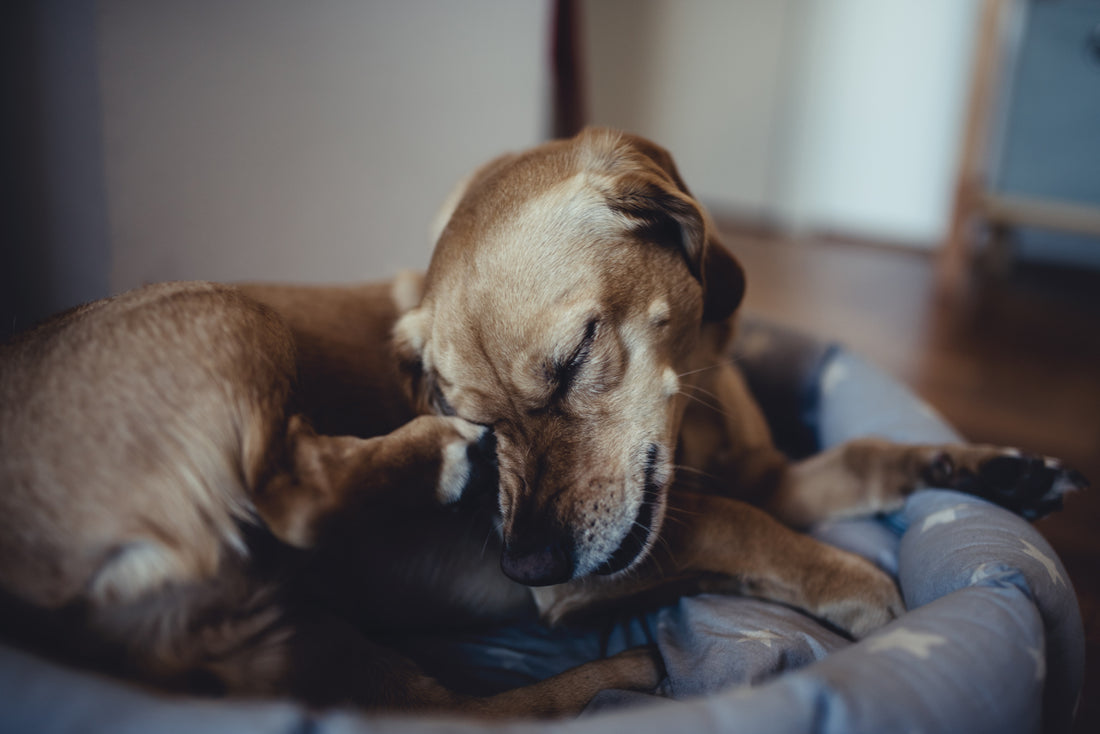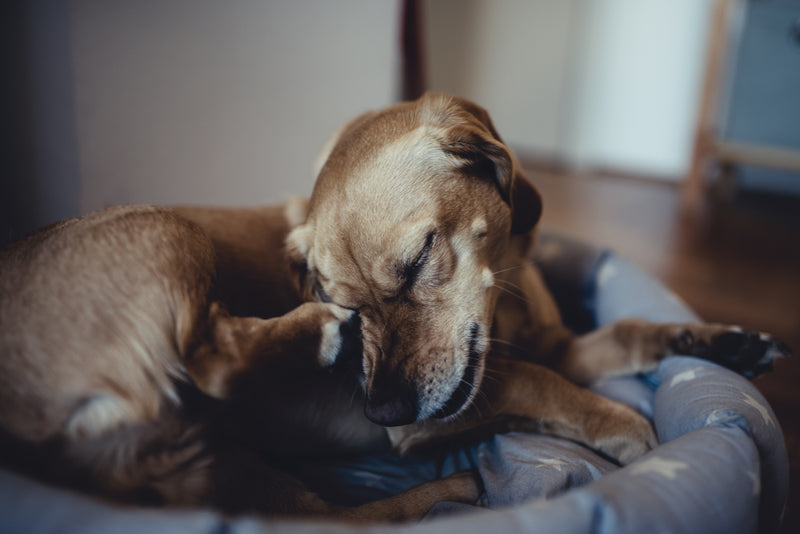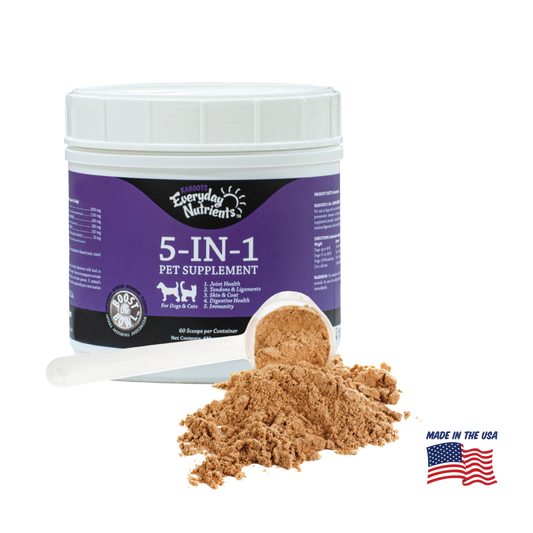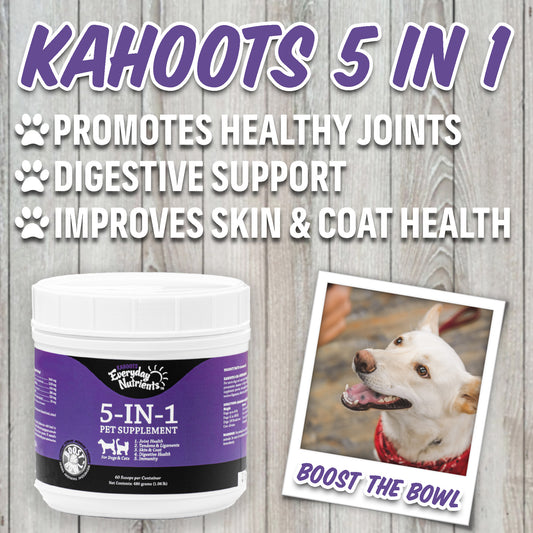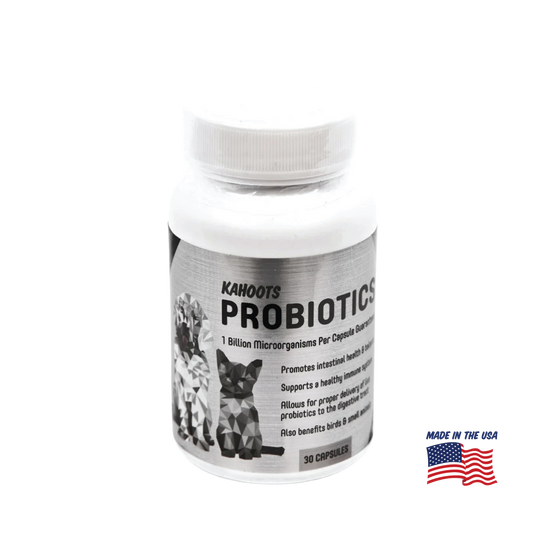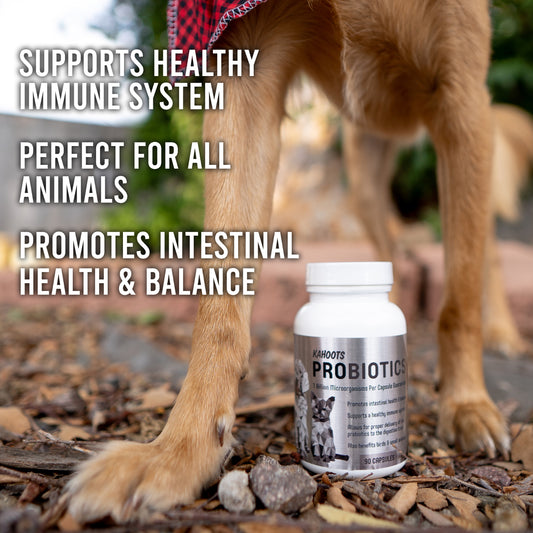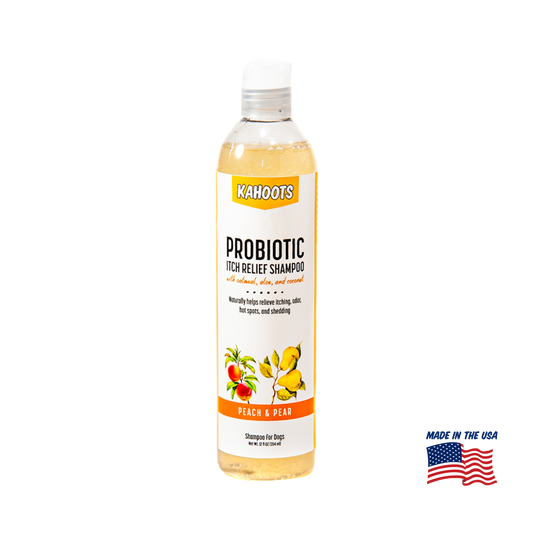Your dog has a rash. We feel for them (and for you). It’s hard to watch your buddy suffer through the annoyance of an itching, blistering, and festering rash without knowing how to help them feel better.
Rashes happen. However, there are ways to soothe the irritation and help your dog’s skin heal quickly so that they don’t suffer for too long. Ready to see how?
Let's get you equipped to address your dog’s rash and prevent them from happening in the future.

My dog has a rash, how can I treat it?
The first thing you should do that will help in most cases is the following:
1 - Use a skin healing, irritation soothing topical treatment like our Kahoots Wound Care Spray or Dr. Gold’s hot spot spray for itch relief to begin healing the wound.
2 - Keep the rash and the area around it clean. Wipe your dog’s belly and paws down with a clean rag or cleansing wipe after they’ve been outside. Keep their skin clear of environmental irritants like poison oak, pollens, and harsh chemicals by bathing them with a gentle shampoo formulated for itch relief.
3 - Feed them a simple diet with high-quality meat proteins and limited carbs to eliminate potential food intolerances. Controlling the sugars in their diet eases any possible yeast infections.
Following these three steps should put your dog on the road to clear skin. However, if you want to give them the best chance to heal quickly and prevent rashes from developing in the future, here are some additional things you could do.
Begin introducing supplements like salmon oil to their diet. Salmon oil is a source of Omega 3 and 6 fatty acids. These are the basic building blocks for repairing and maintaining your dog’s vital organs (including their skin). No matter how well their primary diet is formulated, it’s likely not giving them enough of these essential fatty acids on its own.
Adding a probiotic supplement to their food will aid in digestion. Increasing how efficiently your dog digests their food increases their chances of quickly healing the irritation, preventing the buildup of bad bacteria which could be contributing to the rash, and keeping their body functioning in a healthy way. Probiotics also help prevent any yeast in the digestive tract from blooming on the skin and causing rashes.
Adding regular grooming to their routine will help to keep their skin healthy and increase your chances of preventing a rash from developing in the first place. However, if you follow the three steps outlined above, that should put your dog on the road to clear skin and no more annoying irritation.
Now, if after about a week of using this protocol, the rash hasn’t cleared, you may be dealing with a deeper issue. Keep reading and we’ll get to the root cause of your dog’s rash and find a way to help them feel better.
Note: if you suspect a rash is due to a severe allergic reaction, a medical issue like cushings, or a parasite that made its way into your dog’s digestive system, see your vet as soon as possible.
What are the root causes of my dog’s rash?
The most common causes of rashes on dogs range from environmental irritants, to diet, to stress. You should evaluate each of the following and take the appropriate action to mitigate their effects on your dog.
Heat
Heat can cause some dogs to develop rashes in their skin folds and high motion areas like the groin, belly, or the inside of their hips. This is especially true with our southern California summers. Heat and humidity, friction, and an inability to get completely clean or dry results in irritation accompanied by a secondary bacterial infection—creating the rash.
If you suspect that your dog might have a heat rash, here are some things you can do to help:
Hydrocortisone creamHydrocortisone cream will treat the redness and the irritation of your dog’s skin. However, be sure to speak with a vet first. They can tell you exactly how much and how often to safely use hydrocortisone cream on your dog.
Aloe veraJust like with sunburns, aloe vera gel soothes and works to heal heat rashes! Aloe vera is safe for dogs. Just make sure the gel you use is just aloe. If you have access to an aloe plant, fresh juice will work best.
Cold towelOf course, a cold towel placed on the rash will not heal the rash completely, but the cooling sensation will be a welcome relief for your dog.
Note: Want to try a product specifically formulated to ease the symptoms of these rashes? Zymox Topical Spray combines aloe vera and hydrocortisone with enzymes proven to fight yeast and soothe irritated skin while offering itch relief.
Infections
There are two potential infections that commonly lead to your dog developing a rash: bacterial and fungal.
Bacterial infections often follow some sort of abrasion or other skin trauma like a cut. If your dog is experiencing hair loss, lesions that resemble pimples around the rash, crusty, dry, or flaky skin, after experiencing some sort of skin trauma, they might have a bacterial infection. They should see a vet right away for anti-bacterial treatment.
Fungal infections like ringworm or yeast infections can be caused by a number of different factors. A carb-heavy diet, heat, and poor hygiene can all contribute to a fungal infection caused rash. However, a rash caused by this type of infection is often soothed by an anti-fungal shampoo or an antifungal spray. Topical treatments like these might even be enough to clear up ringworm. However, clearing a yeast infection rash is more systemic and would require a longer healing process involving a change in diet, the introduction of probiotics, and maybe even some lifestyle changes.
Allergies and Food Intolerance
Dogs have allergies and intolerances just like we do. They can have an intolerance (or in rare cases, allergies) to food or have an allergy to environmental factors like pollen. Many dogs develop intolerances to chicken, for example, which can be found in many dog food formulas. If your dog has developed a rash from a reaction to their food or the environment, you can treat their symptoms immediately with an Animal Allergy Support product, or an antihistamine like Benadryl.* But for lasting relief, here’s what you can do.
Keep your dog in a controlled environment for a time. Walk them on a leash, keep them away from cleaning supplies, try to keep them indoors as much as possible. If after a few days you see improvement, they’re likely having some sort of reaction to something in their environment.
Try an elimination diet. Limited-ingredient diets, hypoallergenic diets, or dog foods with high-quality proteins like our Beef and Salmon dog food recipes are free of the most common intolerances for dogs. If you change up your dog’s diet and you notice an improvement after about two weeks, they may have a dietary allergy. You can then slowly reintroduce ingredients to determine what, exactly, they’re reacting to.
*consult your vet before giving your dog antihistamines. Giving the wrong dosage could be toxic.
Pests and parasites
Irritation from pests and parasites (like fleas or ticks) can cause serious discomfort for your dog. Fleas, mites, and ticks can cause irritation and small lesions in their skin, exposing your dog to various infections. Luckily, rashes caused by surface-level pests are relatively easy to identify. Look closely at your dog's skin, paying particular attention to their belly and groin area. If pests have made their home in your dog’s coat, you’ll be able to see them. If you find evidence of pests, take the appropriate steps to eliminate them. Once the pests are gone, the rash can be cleared with treatment.
Contact irritation
It’s possible that your dog’s rash is from simple contact irritation. Poison oak, harsh chemicals from cleaning products, or even some detergents found in dog shampoo could be causing the rash. To rule out contact irritation, give your dog a bath with a soothing, probiotic shampoo, natural oil shampoo, or aloe or oatmeal-based shampoo. These types of detergent-free shampoos work well for dogs with skin issues. Be sure to keep them clean and in a controlled environment until they heal.
Something deeper
If none of these common root causes fit, your dog might be getting their rash from something deeper. It could be a behavioral issue brought on by stress or boredom, or it could be something like a genetic predisposition, or even a hormonal issue. If you’re unable to track down the root cause of your dog’s rash on your own, speak with a vet. They may need to take some skin scrapings as well as blood, urine, and fecal samples to determine the best way to nurse your dog’s skin back to its natural, healthy state.
How do I prevent my dog’s rashes?
The best way to handle your dog’s rashes is to prevent them from developing in the first place. Maintain good hygiene practices by giving regular baths with a soothing shampoo, using skin health supplements like salmon oil, grooming regularly, and feeding a high-quality diet full of meat protein and free of fillers such as corn, wheat, and soy. This will ensure that their skin stays as healthy and rash-free as possible.
Disclaimer: we are not vets. If you’re concerned for your dog's health, the best thing to do is take them to a vet.

